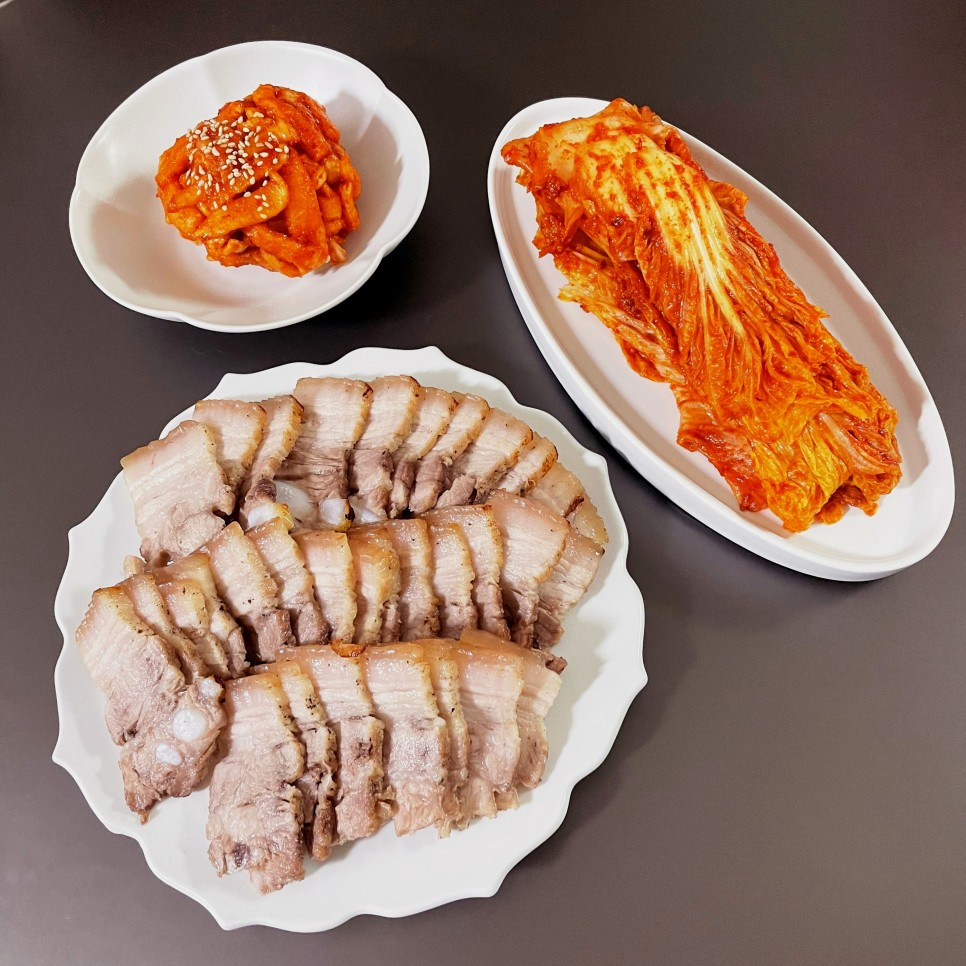Summer Napa Cabbage Kimchi: Refreshing and Crisp Summer Delicacy
Making Summer Napa Cabbage Kimchi: Simple and Quick Recipe for Refreshing Al-Baegi Summer Kimchi

As July and August arrive, your winter kimchi often becomes too sour to enjoy on its own. (Is it just me?) With limited kimchi left from the big batch and store-bought kimchi lacking flavor, while fresh kimchi (geotjeori) feels repetitive, you might crave delicious kimchi but face a long wait until the next kimchi-making season. While I don’t typically eat raw kimchi as a primary side dish, preferring to use it in stews or pancakes, I do enjoy freshly made bossam kimchi. However, the intense craving for kimchi led me to make this summer napa cabbage kimchi.
Kimchi Ingredients- Napa cabbage, 1-3 heads (approximately 2.5 heads)
- Coarse sea salt, as needed (for salting cabbage)
Kimchi Seasoning Ingredients (per 1 head of cabbage)- Minced garlic, 2 Tbsp
- Minced ginger, 0.3 Tbsp
- Fish sauce (Kkanari), 1 Tbsp
- Salted fermented shrimp (finely minced), 1/2 Tbsp
- Sugar, 2 Tbsp~ (adjust to taste)
- Plum extract, 2 Tbsp
- Gochugaru (Korean chili flakes), 2/3 cup
- Cooked rice, 2-3 spoonfuls
- Apple, 1/4
- Onion, 1/4 (small)
- Minced garlic, 2 Tbsp
- Minced ginger, 0.3 Tbsp
- Fish sauce (Kkanari), 1 Tbsp
- Salted fermented shrimp (finely minced), 1/2 Tbsp
- Sugar, 2 Tbsp~ (adjust to taste)
- Plum extract, 2 Tbsp
- Gochugaru (Korean chili flakes), 2/3 cup
- Cooked rice, 2-3 spoonfuls
- Apple, 1/4
- Onion, 1/4 (small)
Cooking Instructions
Step 1
First, prepare and wash the cabbage thoroughly. I used two heads of ‘al-baegi’ (early harvest) cabbage and one head of whole Napa cabbage from Haenam, totaling about two and a half heads. Cut the cabbage in half lengthwise and wash it under running water. You can also separate the leaves and wash them individually.

Step 2
Place the washed cabbage in a plastic bag and sprinkle coarse sea salt generously between the leaves. Ensure the salt is evenly distributed, especially in the thicker parts of the cabbage leaves, to help it draw out moisture effectively. If you’re making a smaller batch, like half a head of ‘al-baegi’ cabbage for geotjeori, regular fine sea salt is acceptable.

Step 3
After thoroughly salting the cabbage, it’s time to let it wilt. Seal the plastic bag tightly and turn the cabbage every 30 minutes, rotating its position (top to bottom, left to right). Let it salt for about 3 hours. This process ensures the cabbage softens evenly and develops a crisp texture.

Step 4
To check if the cabbage is properly salted, gently bend a piece of the thick stem. If it bends without breaking easily, it’s perfectly salted and ready for the next step.

Step 5
Rinse the well-salted cabbage two or three times under cold running water to remove excess salt. Squeeze out as much water as possible by hand, then place the cabbage cut-side down on a rack to drain completely. Thoroughly draining the cabbage is crucial for achieving the right seasoning balance and preventing it from becoming mushy.

Step 6
Personally, I prefer cabbage kimchi that is slightly under-salted, retaining a pleasant crunch. It’s somewhere between geotjeori and fully fermented kimchi, reminiscent of delicious bossam kimchi. Halfway done with making summer cabbage kimchi! Now, let’s prepare the seasoning.

Step 7
Combine the seasoning ingredients in a blender: 2 Tbsp minced garlic, 0.3 Tbsp minced ginger, 1 Tbsp kkanari fish sauce, 1/2 Tbsp finely minced salted fermented shrimp, 2 Tbsp sugar (or more, to taste), 2 Tbsp plum extract, 2/3 cup gochugaru, 2-3 spoonfuls of cooled cooked rice, 1/4 apple, and 1/4 small onion. For one head of cabbage, this is the approximate amount; I tripled this for my 2.5 heads. Using kkanari fish sauce instead of anchovy fish sauce often results in a cleaner kimchi flavor. If you desire a bossam kimchi profile, reduce the garlic slightly and increase the sugar. Ensure the rice is cooled before blending. Alternatively, making a simple flour or sweet rice flour paste (pul) can add a deeper, richer flavor.

Step 8
Blend all the ingredients until smooth to create the kimchi seasoning! If you don’t have a blender, you can use a grater. You can also omit the apple and onion for a simpler version. Using a flour paste or sweet rice flour paste instead of rice is another excellent option.

Step 9
Generously coat the drained cabbage with the prepared kimchi seasoning. This is the final step in making your delicious summer cabbage kimchi! It’s surprisingly easy and quick.

Step 10
Spread the seasoning thoroughly onto every part of the cabbage leaves. Pack the kimchi tightly into a container. For immediate consumption, you can plate individual servings. Although the original intention was to make bossam kimchi, it turned into a delicious batch of regular kimchi! For a sweeter taste, add more plum extract or sugar, and slightly reduce the garlic for a flavor comparable to popular bossam kimchi restaurants. Serving this with ‘mull-free’ bossam and crunchy radish kimchi makes for a meal far superior to store-bought options. Try making this surprisingly delicious summer cabbage kimchi – it’s easier than you think!




